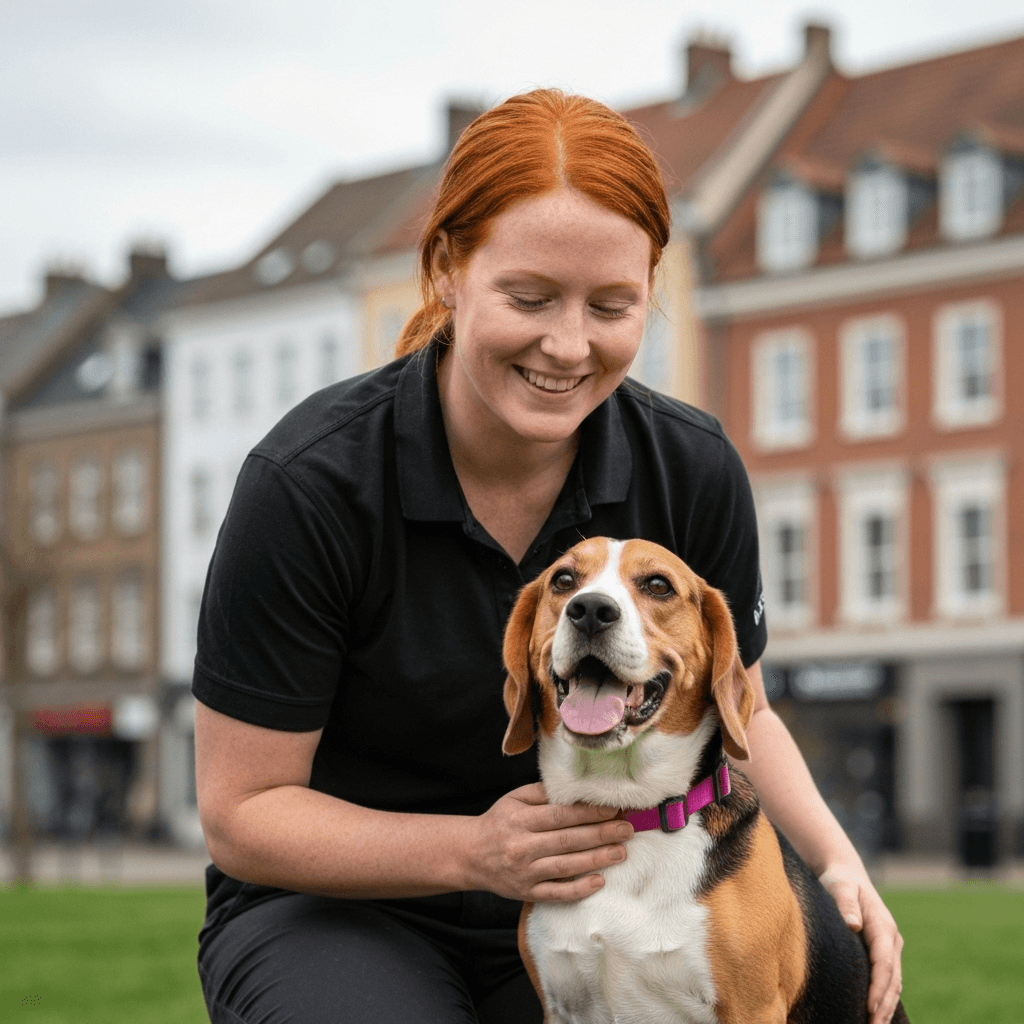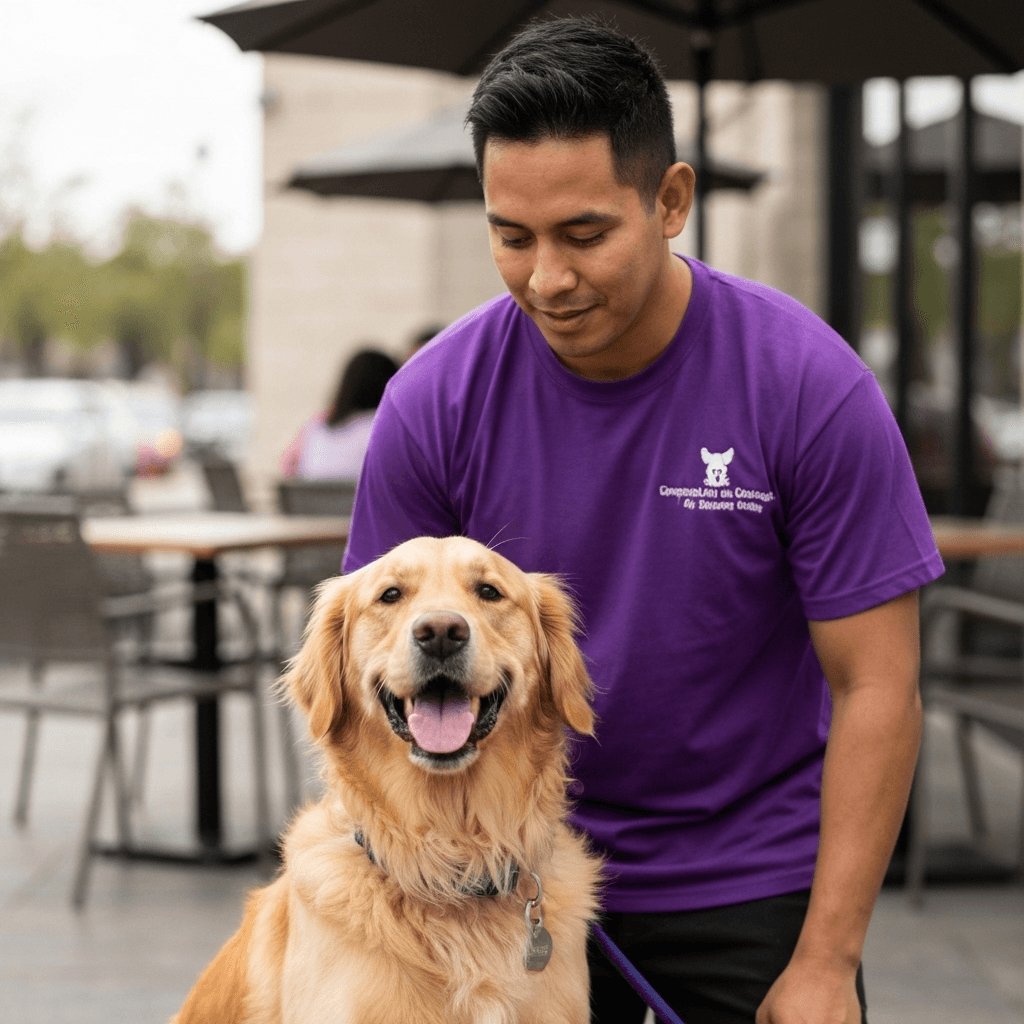Your Complete Guide to Choosing a Dog Trainer in Milwaukee
Living with a dog in Milwaukee means navigating lakefront paths, busy sidewalks, and neighborhood events together. Your pup needs to handle everything from Bay View patios to East Side foot traffic, and that’s where good training makes all the difference.
The right trainer will help your dog walk calmly on the Oak Leaf Trail, greet people politely at the Third Ward riverwalk, and stay relaxed when scooters and buses rumble by. It’s about preparing your dog for real Milwaukee life, not just perfect classroom behavior.
How to Choose the Right Trainer
Start by looking for trainers who use positive reinforcement methods and understand city living. You want someone who gets that your dog needs to master apartment elevator rides, crowded Veterans Park paths, and sitting quietly under patio tables.
Credentials matter when you’re comparing trainers. Look for certifications like CPDT-KA, KPA-CTP, and behavior credentials such as IAABC-CDBC or CBCC-KA. If a trainer mentions specialized programs like CTC, ask them to explain how they apply these methods with your dog.
Think about what format works best for your situation. In-home coaching is perfect for tackling door manners, elevator etiquette, and greeting visitors in your actual space. Group classes help your dog learn to focus around other dogs before you tackle busier spots like Brady Street or the riverwalk.
Some trainers offer day training if your schedule is packed, but make sure you understand exactly what happens between visits and how you’ll practice the skills they’re teaching.
Common Dog Training Methods Explained

Reward-based training builds trust between you and your dog while making it easier to follow local leash laws and control requirements. These methods also reduce stress and frustration when you’re navigating tight sidewalks or crowded park paths.
Basic obedience covers the essentials: sit, down, stay, place, recall, and leash walking. These skills help your dog handle lakefront distractions and busy intersections with confidence. Puppy training focuses on the building blocks like socialization, potty training, crate comfort, and leash walking so your young dog can handle city sights and sounds.
When dogs have bigger challenges like fear, reactivity, or separation anxiety, behavior modification uses careful desensitization and counterconditioning to help them feel more comfortable. This work takes patience and consistency, but it makes a huge difference for anxious or fearful dogs.
Private lessons and in-home training let trainers customize everything to your building rules, daily routines, and neighborhood walking routes. Group classes work well once your dog can concentrate around other dogs and people without getting overwhelmed.
Board and train programs can speed up the learning process, but make sure the trainer uses humane methods, gives you regular updates, and has a clear plan for transferring skills back to you when your dog comes home. Specialized programs like service dog training and therapy dog training require step-by-step public access preparation and clear testing standards.
Average Cost of Dog Training in Milwaukee (Updated for 2025)
Training costs vary based on the trainer’s experience, session length, and whether they come to you or you go to them. Here’s what Milwaukee pet owners typically pay in 2025.
| Service Type | Average Cost (Milwaukee/Milwaukee County) |
|---|---|
| Puppy classes (4–6 weeks) | $150–$275 total |
| Group obedience training (4–6 weeks) | $160–$300 total |
| Private lessons (60–90 min) | $110–$185 per session |
| In-home coaching packages (4–6 visits) | $450–$900 total |
| Day training (trainer works your dog + handoff) | $500–$950 per week |
| Initial behavior consult (reactivity/anxiety) | $150–$250 |
| Board and train (2–4 weeks) | $2,200–$4,500 total |
Expect to pay travel fees if the trainer needs to drive farther across Milwaukee County, and higher rates for complex behavior issues. Many trainers offer a free consultation or evaluation so you can make sure you’re a good fit before committing to a full program.
Questions to Ask a Potential Dog Trainer
- What methods do you use, and how do you keep sessions positive and low-stress?
- What credentials do you hold, such as CPDT-KA or KPA-CTP, and do you continue your education with programs like CPDT-KSA?
- Do you have experience working with dogs in downtown settings, crowded lakefront areas, and apartment buildings?
- What’s your approach to my dog’s specific issues, and how will we track progress?
- Do you offer in-home sessions, group classes, or day training, and which would work best for my goals?
- What’s included in your packages, how many sessions do I get, and what’s your cancellation policy?
- Do you carry liability insurance, and can you show me proof?
- If you offer board and train, how will you teach me to maintain the skills once my dog comes home?
- How should I practice between sessions, and how will you adjust the plan as we make progress?
- Do you work with veterinarians when behavior issues might have medical components?
Milwaukee Rules and Considerations for Dog Owners
Milwaukee has city and county regulations designed to keep everyone safe and maintain good neighbor relationships. Understanding these rules helps you train your dog appropriately and avoid problems down the road.
Dogs must be leashed in all public spaces except designated off-leash dog parks. Use a standard 6-foot leash on sidewalks, trails, and in parks. You’re also required to pick up and properly dispose of pet waste everywhere you go.
Wisconsin requires current rabies vaccination with a visible tag, and dogs 5 months and older need annual city or county licensing. Excessive barking can be considered a nuisance, especially important in apartments and neighborhoods with shared walls.
If you’re working with a trainer who wants to practice in parks, they may need permission and proof of insurance for commercial activities. Check local rules before scheduling public training sessions.
For complete city regulations, animal care information, and licensing details, visit the City’s page at City of Milwaukee animals and pet rules. State vaccination requirements are explained by Wisconsin DHS rabies guidance.
Milwaukee County operates several off-leash areas that require permits; you can find locations and rules at Milwaukee County Parks dog parks.
Local Milwaukee Resources for Dog Owners
These locations offer great opportunities for safe training practice, enrichment, and legal off-leash time. Always check posted rules, permit requirements, and operating hours before you visit.
The county maintains three fenced dog exercise areas: Estabrook Park, Granville, and Runway Dog Exercise Area near Mitchell Airport. Veterans Park offers excellent lakefront paths and open lawns for leashed practice sessions.
Several trail systems work well for training walks, including Oak Leaf Trail segments through the East Side and Bay View, and the Hank Aaron State Trail through the Menomonee Valley. MADACC provides countywide support for licensing and lost pet services.

Common Questions About Dog Training in Milwaukee
How much does in-home dog training cost?
Most Milwaukee trainers charge $110–$185 per in-home visit, with package discounts available. Behavior modification work typically starts at the higher end of this range.
Is in-home dog training worth it?
Absolutely, because it addresses problems exactly where they happen. Your trainer can work on door manners in your entryway, practice leash skills on your actual walking route, and teach apartment etiquette in your building’s hallways and elevators.
Can you pay someone to house train your dog?
Many trainers offer puppy programs that include potty training schedules, crate training, and prevention strategies. Day training can be especially helpful when your work schedule makes consistent house training difficult.
What is the 3-3-3 rule for dog training?
This guideline suggests dogs need about 3 days to decompress in a new situation, 3 weeks to learn new routines, and 3 months to feel completely settled. Good training programs work with this timeline using short, positive sessions.
How long will it take to reach my training goals?
Most dogs without serious behavioral issues show clear progress in 4–8 weeks with daily practice. Dogs dealing with reactivity, fear, or aggression often need several months of careful, consistent work.
What should I bring to group classes?
Pack a flat collar or harness, 6-foot leash, high-value treats, water, and vaccination records if the trainer requests them. Leave retractable leashes at home since they make it harder to maintain control in group settings.
What’s the leash law in Milwaukee?
Dogs must be leashed and under your control in all public areas except designated off-leash dog parks. Keep a standard leash for sidewalk walks, trail hikes, and public events.
Do I need a dog license in Milwaukee or Milwaukee County?
Yes, Wisconsin requires licensing for all dogs 5 months and older through local city or county processes. You’ll need current rabies vaccination proof, and fees vary by location and whether your dog is spayed or neutered.
What shots does my dog need in Milwaukee County or Wisconsin?
Rabies vaccination is required statewide, with specific timing requirements outlined in state health regulations. Your veterinarian may also recommend distemper-parvo combination vaccines and bordetella based on your dog’s lifestyle and exposure risks.
Are dog trainers required to be licensed in Milwaukee or Milwaukee County or Wisconsin?
No special state license exists for dog trainers, but they must follow standard business regulations. Trainers who board dogs may need local permits and insurance, so ask for proof of liability coverage and any required business approvals.
Where can I practice off-leash recall?
Use the fenced Milwaukee County dog parks, but you’ll need the required permit first. Visit during quieter times so you can practice safely without crowding or distracting other park users.
Which dog parks allow training around Milwaukee?
Estabrook, Granville, and Runway Dog Exercise Areas are designed for off-leash activities and can work for training. Keep sessions brief, give other users plenty of space, and follow posted park etiquette guidelines.
What beaches and trails allow dogs for training?
Leashed dogs are welcome on most Oak Leaf Trail segments and lakefront paths near Veterans Park. Use the distance from distractions to your advantage, reward calm behavior consistently, and keep training sessions short to avoid overwhelming your dog.
How do I verify a trainer’s credentials?
Ask for certification numbers and information about how to verify them. Look for programs like CPDT-KA, KPA-CTP, IAABC-CDBC, CBCC-KA, and comprehensive programs like CTC.
Do parks require permits for training sessions?
Milwaukee County’s off-leash areas require dog park permits for all users, and commercial training activities may need additional permission and insurance documentation. Check the county parks website before scheduling any professional training sessions.
Finding the right professional dog trainer who understands Milwaukee’s unique challenges, from apartment living to lakefront crowds, makes all the difference in your dog’s success. Focus on trainers who use positive methods, set realistic goals, and help you practice in the real places where you and your dog spend time together.